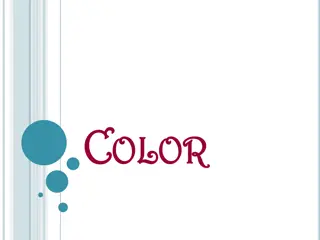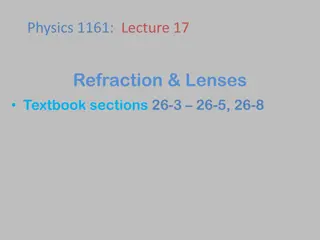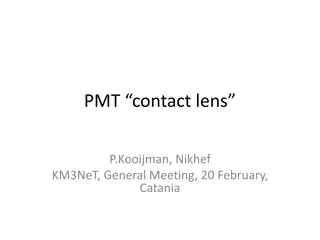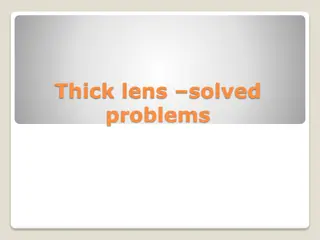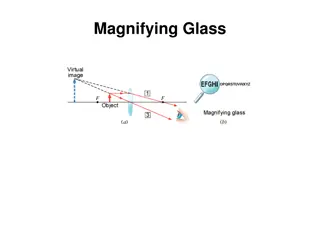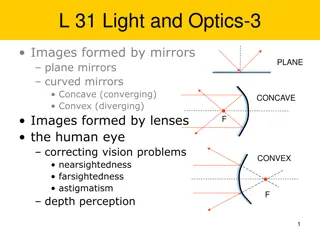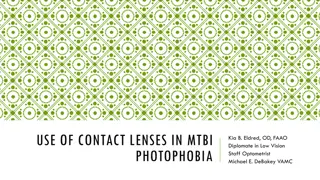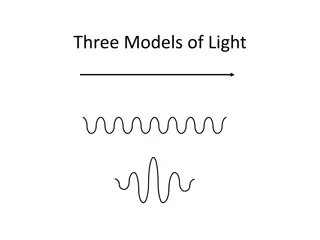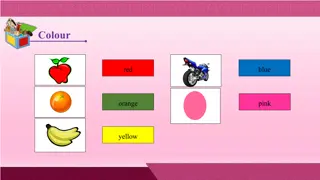Understanding Light and Lenses: Exploring Colors and Images Formed
Explore the fascinating world of light and lenses in this module. Discover how lenses work, types of lenses like convex and concave, images formed by lenses, and the dispersion of sunlight into seven colors. Engage in activities showcasing the colors of sunlight and delve into the enchanting realm of optics.
Download Presentation

Please find below an Image/Link to download the presentation.
The content on the website is provided AS IS for your information and personal use only. It may not be sold, licensed, or shared on other websites without obtaining consent from the author. Download presentation by click this link. If you encounter any issues during the download, it is possible that the publisher has removed the file from their server.
E N D
Presentation Transcript
Class-VII SUBJECT:SCIENCE CHAPTER-15 LIGHT MODULE-3/3 PREPARED BY:SUNIL KUMAR YADAV T.G.T (CHEM/BIO) A.E.C.S. NO.2 ,RAWATBHATA
LENSES Lenses are transparent and light can pass through them . A magnifying glass which is used to read very small print or to observe the body parts of a cockroach or an earthworm. Magnifying lens is actually a type of lens. Lenses are widely used in spectacles , telescopes and microscopes
TYPES OF LENSES CONVEX LENS : Those lenses which are thicker in the middle than at the edges are called convex lenses. A convex lens converges (bends inward) the light that falls on it .Therefore it is called a converging lens. A magnifying lens is a convex lens CONCAVE LENS :Those lenses which are thinner at the middle than at the edges are called concave lenses. A concave lens diverges (bends outwards) the light that falls on it. Therefore it is called diverging lens.
IMAGES FORMED BY LENSES A convex lens forms an image that is : The image formed by a convex lens may be smaller or larger than the object. The image may be real (can be obtained on a screen) or virtual (cannot be obtained on a screen). The image may be erect or inverted. A concave lens forms an image that is : Virtual (cannot be obtained on a screen ). Erect Small in size as compared to the size of object and appears far away from the lens.
USES OF LENSES Convex lens is used as a magnifying lens to see tiny objects. Lenses are used in spectacles . Lenses are used in microscopes.
SUNLIGHT WHITE OR COLOURED ? ACTIVITY TO SHOW THAT SUNLIGHT CONSISTS OF SEVEN COLOURS Take a glass prism . Allow a narrow beam of sunlight through a small hole in the window of a dark room to fall on one face of the prism. Let the light coming out of the other face of the prism fall on a white sheet of paper or on a white wall. OBSERVATION : It is observed that light coming out of the other face of the prism consists of seven colours similar to those seen in a rainbow. This shows that the sunlight consists of seven colours. The sunlight is said to be white light. This means that the white light consists of seven colours. DISPERSION OF LIGHT: The process of splitting white light into seven colours on passing through a prism is called dispersion of light and the pattern of seven distinct colours obtained on a screen is called spectrum.
SOAP BUBBLES COMPACT DISC RAINBOW
NEWTONS DISC Take a circular cardboard disc and divide it into seven segments. Paint the seven colours as found in a rainbow. Make a small hole at the centre of the disc . Fix the disc loosely on the top of a refill of a ball pen . Now rotate the disc in the daylight. When the disc is rotated fast , the colours painted on the disc get mixed together and the disc appears to be whitish. Such a disc is popularly known as Newton s disc.


